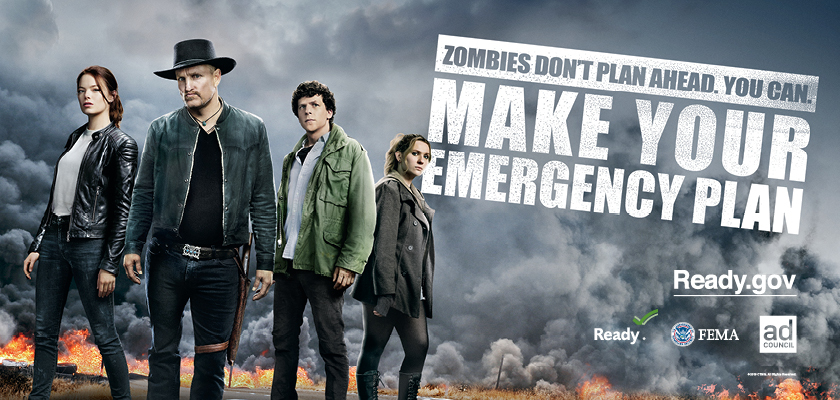|
FEMA’s Ready Campaign and the Ad Council joined with Sony Pictures on their upcoming film “Zombieland: Double Tap” to promote the critical message of emergency preparedness.
A decade after the first film, “Zombieland,” the lead cast and original writers and director have reunited for “Zombieland: Double Tap.” As part of the sequel’s release, Sony Pictures developed a public service announcement with original film footage for the Ready Campaign. The PSA will air before the film in movie theaters across the country.
The PSA and promotional posters feature Woody Harrelson, Jesse Eisenberg, Abigail Breslin, Emma Stone, and other cast members describing what families should do now to prepare for disasters with the theme, “Zombies don’t plan ahead. You can. Make your emergency plan.”
As part of the promotion, the @Ready Twitter account and the Ready Facebook page will be using the PSA to encourage the public to get prepared for emergencies.
The new PSA is an extension of FEMA's Ready campaign, which has helped to generate more than 100 million unique visitors to the campaign’s website Ready.gov, since its launch in 2003. Through the Ad Council, to date, the Ready campaign has received more than $1.6 billion in donated media.
For more information on what to do before, during or after emergencies, visit Ready.gov.

On Oct. 1, FEMA replaced the National Flood Insurance Program information technology system with Pivot as the program's official system of record. This transition is intended to help modernize and reduce the complexity of the NFIP by enabling faster processing of insurance information.
The new system will enhance reporting capabilities, enable attachment of important information, provide single point of access, validate data, speed event response times, and improve overall efficiency.
Access is available online at pivot.fema.gov to Write Your Own Insurance Companies, insurance agents and adjusters, Write Your Own vendors, the NFIP Direct, as well as state, local, tribal, and territorial, officials.
On Oct. 1, FEMA announced key changes for the National Flood Insurance Program (NFIP), to begin on Apr. 1, 2020. These changes include updated increases to conform to the premium rate caps established by the Biggert-Waters Flood Insurance Reform Act of 2012 (BW-12) and the Homeowner Flood Insurance Affordability Act of 2014 (HFIAA).
Beginning on April 1, 2020, renewal premiums will increase an average of 11.3 percent. These amounts do not include the HFIAA Surcharge, or the Federal Policy Fee (FPF). Nearly 80 percent of policyholders already pay a full-risk rate and will therefore not experience this rate increase. The Severe Repetitive Loss Premium is increasing to 10 percent for all policies covering properties with that designation.
In addition, it was also announced that annual premium increases of 14.9 percent for preferred risk policies and 14.8 percent for newly mapped procedure policies will be effective on Jan. 1, 2021.
The guidance and premium rates in this edition do not represent any changes as a result of FEMA’s planned Risk Rating 2.0 initiative. FEMA continues its preliminary analyses and internal review on how premium rates may change. Once completed, FEMA will provide additional guidance and updates in the future.
In addition to the rate increases, revisions to the NFIP Flood Insurance Manual, which is updated twice a year, took effect Oct. 1, 2019. FEMA incorporated the NFIP program changes published in April 2019 into this edition.
The updated edition of the "Flood Insurance Manual" does not change flood insurance coverage or supersede the terms and conditions of the standard flood insurance policy. The changes in effect include:
- An updated list of Community Rating System eligible communities (Table 3).
- An updated list of resources and contact information for technical assistance.
- Several updates or changes to various Letters of Map Revision.
The two bulletins announcing these October changes are available online. Visit FEMA.gov to review the NFIP Flood Insurance Manual.
FEMA can now provide Hazard Mitigation Grant Program (HMGP) assistance to any area that received a Fire Management Assistance Grant (FMAG). This change is a result of the passage of the Disaster Recovery Reform Act amended Section 2014 of the Robert T. Stafford Disaster Relief and Emergency Assistance Act. As required by the act, FEMA recently provided an annual fiscal year report to Congress on grant efforts.
The total HMGP Post Fire funding amount available for each FMAG declaration in 2019 is $454,432 for states with a standard hazard mitigation plan and $605,909 for states with an enhanced hazard mitigation plan. FEMA recalculates the national average and the amount of funding available at the beginning of every fiscal year when the first FMAG is awarded. During this past fiscal year, seven states received FMAGs for a total of nine declarations totaling $4.3 million.
Visit FEMA.gov to review the Wildfire Assistance Funding and Project Summary report and for additional information about the HMPG Post Fire program.
The fourth edition of the Public Assistance Program and Policy Guide is scheduled for publication in January 2020.
FEMA is releasing the updated draft version for a 45-day public comment period. The draft guide and accompanying comments matrix is located on the FEMA website. FEMA will accept public comments submitted through Nov. 18.
FEMA requests that all comments be submitted to FEMA-PAPolicy@fema.dhs.gov using the comments matrix.
FEMA has archived previous editions of the Public Assistance Program and Policy Guide. Version 4 of the guide will supersede Version 3.1 (published in April 2018) and will be applicable to incidents declared on or after the date of publication.
FEMA will host two webinars for state and local partners on the changes to Version 4 of the guide and the process for submitting comments. Both webinars will cover the same information.
- Webinar 1: Oct. 16 from 3:30 - 4:30 ET
Register on Adobe Connect
Teleconference: 800-320-4330, PIN 835947#
- Webinar 2: Oct. 17 from 3:30 - 4:30 p.m. ET
Register on Adobe Connect
Teleconference: 800-320-4330, PIN 835947#
FEMA is adjusting the following based on the Fiscal Year 2020 Consumer Price Index (CPI): statewide per capita indicator, the countywide per capita indicator, the maximum amount for small project grants, the minimum amount for project worksheets, and the maximum amount of assistance under the Individuals and Households Program. These adjustments will impact all disasters declared on or after October 1, 2019.
- Statewide per capita impact indicator is now $1.53.
- Countywide per capita impact indicator is now $3.84.
- Maximum amount for small project grants under the Public Assistance Program is $131,100.
- Minimum amount that can be approved for any Project Worksheet under the Public Assistance Program is $3,300.
- Maximum amount of Individuals and Households Program financial assistance increased for Housing Assistance to $35,500 and for Other Needs Assistance to $35,500. This increases the maximum amount of available coverage under any Group Flood Insurance Policy.
For additional information about these adjustments, review the notices on the Federal Register.
FEMA, in partnership with ShakeOut, encourages everyone to take action and register their participation in the Great ShakeOut Earthquake Drill.
The 2019 International ShakeOut day is Oct. 17. Millions of people worldwide will drop, cover, and hold on during earthquake drills in schools, organizations, communities, and households at 10:17 a.m. local time.
Earthquakes can happen where we work, live, or travel, and earthquake drills are an opportunity for everyone, everywhere, to practice earthquake safety and other aspects of emergency plans. Visit ShakeOut.org to register your participation, find resources, and learn more.
To learn more about earthquake safety visit Ready.gov

Each October, the American Planning Association recognizes and focuses on the importance of community planning and its impacts. This year's theme - "Planning for Infrastructure That Benefits All" - highlights how well-planned infrastructure projects (including roadways, transportation systems, housing, parks, and even broadband networks) strengthen communities, boost the economy, expand opportunity, and promote equitable development.
These themes tie directly to FEMA's National Mitigation Investment Strategy, Community Lifelines, and the development of the new Building Resilient Infrastructure in Communities program, especially in the context of mitigation planning. Communities that plan with citizen’s safety in mind are more resilient and better prepared to face disasters. A good first step to build-in safety considerations into a community is to connect community planning with mitigation planning. Mitigation is most effective when it is coordinated with other plans, processes, policies and decisions.
Mitigation plans are the key to breaking the cycle of disaster damage, reconstruction, and repeated damage. A FEMA-approved local and state hazard mitigation plan is required for applying for mitigation grants. Since the passage of the Disaster Mitigation Act of 2000, FEMA grants totaling approximately $500 million dollars have funded the initial creation or updates of nearly 5,700 mitigation plans. As of June 2019, 87 percent (20,875 local jurisdictions) across the nation have FEMA-approved and adopted local hazard mitigation plans. This includes all 50 states, DC, five territories and 217 tribes.
Visit FEMA.gov to learn more about Hazard Mitigation Planning.

FEMA is participating in the National Building Museum’s annual Big Build Community Day in Washington, DC, on Saturday, Oct. 12. Builders of every age learn side-by-side with community planners, roofers, plumbers, artisans, and more in this hands-on event celebrating how we design and build the places where we work, live, and play. Come experience FEMA's virtual reality experience "IMMERSED," explore construction vehicles, and learn more about the ins and outs of building and construction.
The program is free and hours are from 10 a.m.to 5 p.m. at the National Building Museum, 401 F St. NW, Washington, DC near the Judiciary Square Metro.
|
|